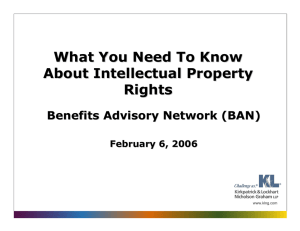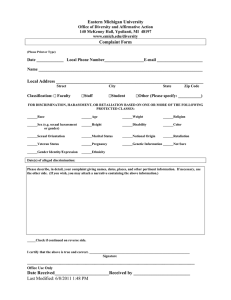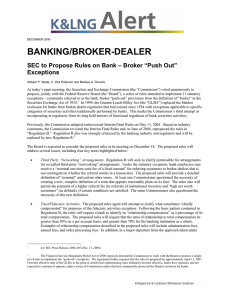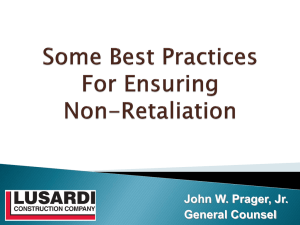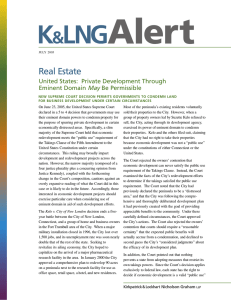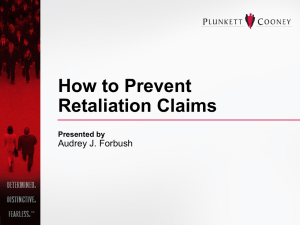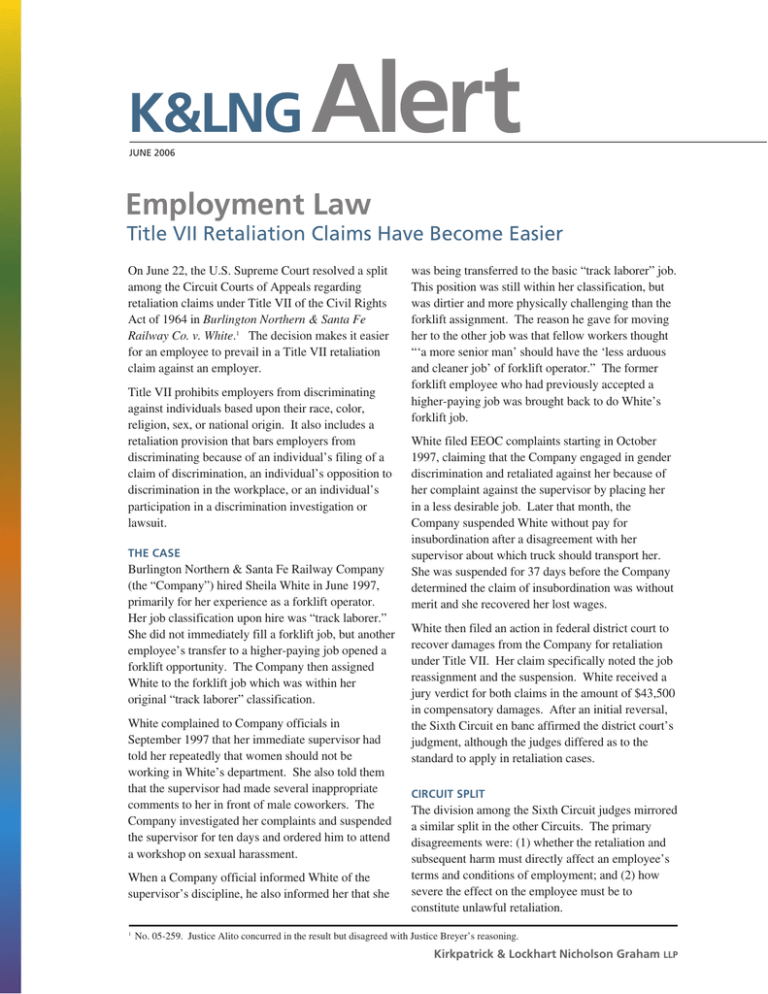
K&LNG
JUNE 2006
Alert
Employment Law
Title VII Retaliation Claims Have Become Easier
On June 22, the U.S. Supreme Court resolved a split
among the Circuit Courts of Appeals regarding
retaliation claims under Title VII of the Civil Rights
Act of 1964 in Burlington Northern & Santa Fe
Railway Co. v. White.1 The decision makes it easier
for an employee to prevail in a Title VII retaliation
claim against an employer.
Title VII prohibits employers from discriminating
against individuals based upon their race, color,
religion, sex, or national origin. It also includes a
retaliation provision that bars employers from
discriminating because of an individual’s filing of a
claim of discrimination, an individual’s opposition to
discrimination in the workplace, or an individual’s
participation in a discrimination investigation or
lawsuit.
THE CASE
Burlington Northern & Santa Fe Railway Company
(the “Company”) hired Sheila White in June 1997,
primarily for her experience as a forklift operator.
Her job classification upon hire was “track laborer.”
She did not immediately fill a forklift job, but another
employee’s transfer to a higher-paying job opened a
forklift opportunity. The Company then assigned
White to the forklift job which was within her
original “track laborer” classification.
White complained to Company officials in
September 1997 that her immediate supervisor had
told her repeatedly that women should not be
working in White’s department. She also told them
that the supervisor had made several inappropriate
comments to her in front of male coworkers. The
Company investigated her complaints and suspended
the supervisor for ten days and ordered him to attend
a workshop on sexual harassment.
When a Company official informed White of the
supervisor’s discipline, he also informed her that she
1
was being transferred to the basic “track laborer” job.
This position was still within her classification, but
was dirtier and more physically challenging than the
forklift assignment. The reason he gave for moving
her to the other job was that fellow workers thought
“‘a more senior man’ should have the ‘less arduous
and cleaner job’ of forklift operator.” The former
forklift employee who had previously accepted a
higher-paying job was brought back to do White’s
forklift job.
White filed EEOC complaints starting in October
1997, claiming that the Company engaged in gender
discrimination and retaliated against her because of
her complaint against the supervisor by placing her
in a less desirable job. Later that month, the
Company suspended White without pay for
insubordination after a disagreement with her
supervisor about which truck should transport her.
She was suspended for 37 days before the Company
determined the claim of insubordination was without
merit and she recovered her lost wages.
White then filed an action in federal district court to
recover damages from the Company for retaliation
under Title VII. Her claim specifically noted the job
reassignment and the suspension. White received a
jury verdict for both claims in the amount of $43,500
in compensatory damages. After an initial reversal,
the Sixth Circuit en banc affirmed the district court’s
judgment, although the judges differed as to the
standard to apply in retaliation cases.
CIRCUIT SPLIT
The division among the Sixth Circuit judges mirrored
a similar split in the other Circuits. The primary
disagreements were: (1) whether the retaliation and
subsequent harm must directly affect an employee’s
terms and conditions of employment; and (2) how
severe the effect on the employee must be to
constitute unlawful retaliation.
No. 05-259. Justice Alito concurred in the result but disagreed with Justice Breyer’s reasoning.
Kirkpatrick & Lockhart Nicholson Graham LLP
Some Circuits insisted that, to be unlawful, the
retaliation must result in a material, adverse change
in the employee’s working conditions. Other Circuits
placed emphasis on the effect the retaliation had on
discouraging the employee from asserting Title VII
rights. The Supreme Court used White’s case to
rectify this split and clarify the difference between
Title VII’s discrimination provision and its retaliation
provision.
RETALIATION DOES NOT NEED TO BE
WORKPLACE RELATED
In its analysis, the Supreme Court first looked to how
close the relationship should be between the
employer’s retaliatory action and the plaintiff’s
employment context. The Court looked at the text of
both the discrimination and retaliation provisions in
the statute and noted that the discrimination provision
explicitly referred to the workplace.2 The retaliation
provision, by contrast, did not have this language to
limit its application to the employment context.3
The retaliation provision broadly forbade an
employer from discriminating based upon opposition
to an employer’s discriminatory practice or
participation in a discrimination claim.
The Court looked to Congress’ intent to see if the
absence of the workplace reference in the retaliation
provision was meant to expand that provision beyond
an action that would adversely affect the employee’s
terms and conditions of employment. The Court read
the absence of employment language in the
retaliation provision as intentional. It stated that
there are many retaliatory actions the employer can
take that are not directly related to employment but
that can effectively deter an employee from
exercising Title VII rights. The Court maintained
that the vitality of the statute depended upon
employees’ willingness to step up and make
complaints or support colleagues’ complaints.
Extending the retaliation provision to include acts
that are beyond adverse employment actions
effectively ensures that employees will not be
deterred by their employers from exercising their
Title VII rights. An example of this extension
beyond employment cited by the Court was filing
criminal charges against an employee who had filed
a discrimination complaint.
ACTION IS MATERIALLY ADVERSE TO THE
REASONABLE EMPLOYEE
In the Court’s view, “a plaintiff must show that a
reasonable employee would have found the
challenged action materially adverse, ‘which in this
context means it well might have dissuaded a
reasonable worker from making or supporting a
charge of discrimination.’”4 The Court emphasized
the distinction between “significant” and “trivial”
harms when it chose the “materially adverse”
language. It noted that Title VII does not prevent an
employee complaining of employer discrimination
from experiencing “petty slights or minor
annoyances that often take place at work and that all
employees experience.” These “petty slights, minor
annoyances, and simple lack of good manners” do
not normally deter employees from reporting
discrimination or participating in complaints.
The Court then concluded that the reasonable
employee standard satisfied the requirement that the
retaliation “provision’s standard for judging harm
must be objective.” However, it then focused the
effective standard of “reasonable” by stating that it
must be reasonable in the context of the individual
employee; i.e., the severity of the harm will often
depend upon the particular circumstances of the
alleged act and the employee involved.
In its discussion, the Court provided several
examples of how the same action can have different
levels of severity depending upon the person’s
circumstances. Changing an employee’s shift or
work schedule may not be significant to most
workers. However, this change may greatly affect a
mother or father with childcare responsibilities. The
Court also noted that a “supervisor’s refusal to invite
an employee to lunch is normally trivial, a
2
It shall be an unlawful employment practice for an employer—(1) to fail or refuse to hire or to discharge any individual, or otherwise
to discriminate against any individual with respect to his compensation, terms, conditions, or privileges of employment, because of
such individual's race, color, religion, sex, or national origin; or (2) to limit, segregate, or classify his employees or applicants for
employment in any way which would deprive or tend to deprive any individual of employment opportunities or otherwise adversely
affect his status as an employee, because of such individual’s race, color, religion, sex, or national origin. 42 U.S.C.A. § 2000e-2(a)
(West 2002).
3
It shall be an unlawful employment practice for an employer to discriminate against any of his employees or applicants for
employment, for an employment agency, or joint labor-management committee controlling apprenticeship or other training or
retraining, including on-the-job training programs, to discriminate against any individual, or for a labor organization to discriminate
against any member thereof or applicant for membership, because he has opposed any practice made an unlawful employment
practice by this subchapter, or because he has made a charge, testified, assisted, or participated in any manner in an investigation,
proceeding, or hearing under this subchapter. 42 U.S.C.A. § 2000e-3(a) (West 2002).
4
Emphasis added.
2
Kirkpatrick & Lockhart Nicholson Graham
LLP
|
JUNE 2006
nonactionable petty slight.” The impact changes,
however, when the supervisor excludes the employee
from a weekly staff meeting or “training lunch” that
provides valuable professional development not
available by any other means. The Court concluded
by saying, “focusing on the materiality of the
challenged action and the perspective of a reasonable
person in the plaintiff’s position…will screen out
trivial conduct while effectively capturing those acts
that are likely to dissuade employees from
complaining or assisting in complaints about
discrimination.”
back pay. In finding that the jury’s verdict was
reasonable on this ground, the Court said that there
was ample evidence to support her claim. White
lived for 37 days over the Christmas holiday with no
income. It was so stressful that she had to seek
medical help. The Court thought that, when given
the choice between an unpaid suspension and filing a
discrimination claim, the looming suspension might
deter employees from coming forward with
complaints—even if the employee eventually might
receive back pay.
IMPLICATIONS OF WHITE
THE COURT’S DISCUSSION OF WHITE’S CASE
Applying its newly endorsed standard, the Supreme
Court upheld White’s jury verdict. The Company did
not refute that the two actions in question, the job
reassignment and the disciplinary suspension, were
retaliation.5 The Company did challenge just how
harmful these retaliatory acts were to White.
The Company’s first argument was that the job
reassignment was not harmful because both jobs fell
within the same job classification with the same pay
and benefits. However, one job was significantly
easier and cleaner than the other. The Court
responded, “Common sense suggests that one good
way to discourage an employee such as White from
bringing discrimination charges would be to insist
that she spend more time performing the more
arduous duties and less time performing those that
are easier and more agreeable.” However,
reassigning a job is not automatically a retaliation
slam dunk. “Whether a particular reassignment is
materially adverse depends upon the circumstances
of the particular case, and ‘should be judged from the
perspective of a reasonable person in the plaintiff’s
position, considering all the circumstances.’”
Here, the jury was justified in concluding that
White’s reassignment was retaliatory discrimination
because the second job was less prestigious, dirtier,
more arduous, and subjectively considered a less
desirable job than the forklift position.
The Company’s second argument was that White’s
suspension without pay was not significant because
she was made whole through her reinstatement with
5
This case expands the rights of employees under the
Title VII retaliation provision. The expansion stems
from the Court’s holding that the retaliation provision
applies not just to adverse employment actions, but
also to actions not directly impacting an employee’s
terms or conditions of employment. Normal,
everyday, facially non-retaliatory employment
actions may become unlawful retaliation in the eyes
of a court because of the context, including factors
outside the workplace. An employer must now make
an effort to forecast whether its actions may
adversely affect an employee’s personal life and
whether this adverse effect could qualify as
“materially” adverse. This judgment also must take
into account what the “reasonable employee” would
think about the employer’s actions.
Even though this is a Title VII decision, it may well
be extended to retaliation claims under other statutes
like the Americans With Disabilities Act or the Age
Discrimination in Employment Act. As always,
employers need to try to be aware of potential
discrimination issues before they become retaliation
claims. With White, an employer’s actions regarding
an employee who has complained of discrimination
will carry greater risk of liability.
Hayes C. Stover
hstover@klng.com
412.355.6476
Jennifer J. Froehlich (Intern)
jfroehlich@klng.com
412.355.7468
While the Company’s actions may not have been severe enough to serve as the basis for a discrimination claim, they were serious
enough to qualify as retaliation.
3
Kirkpatrick & Lockhart Nicholson Graham
LLP
|
JUNE 2006
If you have questions or would like more information about K&LNG’s Employment Law Practice,
please contact one of our lawyers listed below:
Boston
Henry T. Goldman
Mark D. Pomfret
617.951.9156
617.261.3147
hgoldman@klng.com
mpomfret@klng.com
Dallas
Von E. Hays
Jaime Ramón
214.939.4959
214.939.4902
vhays@klng.com
jramon@klng.com
Harrisburg
Carleton O. Strouss
717.231.4503
cstrouss@klng.com
London
Paul Callegari
Los Angeles
+44.20.7360.8194
pcallegari@klng.com
Thomas H. Petrides
Paul W. Sweeney, Jr.
310.552.5077
310.552.5055
tpetrides@klng.com
psweeney@klng.com
Miami
April L. Boyer
Judd J. Goldberg
Carol C. Lumpkin
Michael C. Marsh
305.539.3380
305.539.3344
305.539.3323
305.539.3321
aboyer@klng.com
jgoldberg@klng.com
clumpkin@klng.com
mmarsh@klng.com
Newark
Rosemary Alito
Vincent N. Avallone
973.848.4022
973.848.4027
ralito@klng.com
vavallone@klng.com
New York
Eva M. Ciko
212.536.3905
eciko@klng.com
Palo Alto
Linda L. Usoz
650.798.6702
lusoz@klng.com
Pittsburgh
David J. Kolesar
Stephen M. Olson
Michael A. Pavlick
Hayes C. Stover
412.355.6252
412.355.6496
412.355.6275
412.355.6476
dkolesar@klng.com
solson@klng.com
mpavlick@klng.com
hstover@klng.com
San Francisco
Linda L. Usoz
650.798.6702
lusoz@klng.com
Washington
Lawrence C. Lanpher
202.778.9011
llanpher@klng.com
www.klng.com
BOSTON • DALLAS • HARRISBURG • LONDON • LOS ANGELES • MIAMI • NEWARK • NEW YORK • PALO ALTO • PITTSBURGH • SAN FRANCISCO • WASHINGTON
Kirkpatrick & Lockhart Nicholson Graham (K&LNG) has approximately 1,000 lawyers and represents entrepreneurs, growth and middle market companies,
capital markets participants, and leading FORTUNE 100 and FTSE 100 global corporations nationally and internationally.
K&LNG is a combination of two limited liability partnerships, each named Kirkpatrick & Lockhart Nicholson Graham LLP, one qualified in Delaware, U.S.A. and
practicing from offices in Boston, Dallas, Harrisburg, Los Angeles, Miami, Newark, New York, Palo Alto, Pittsburgh, San Francisco and Washington and one
incorporated in England practicing from the London office.
This publication/newsletter is for informational purposes and does not contain or convey legal advice. The information herein should not be used or relied
upon in regard to any particular facts or circumstances without first consulting a lawyer.
Data Protection Act 1988—We may contact you from time to time with information on Kirkpatrick & Lockhart Nicholson Graham LLP seminars and with our
regular newsletters, which may be of interest to you. We will not provide your details to any third parties. Please e-mail london@klng.com if you would prefer
not to receive this information.
© 2006 KIRKPATRICK & LOCKHART NICHOLSON GRAHAM LLP. ALL RIGHTS RESERVED.

